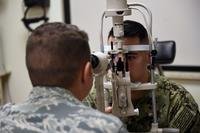DoD Urged to Stop Ignoring ‘Full’ Cost Of Personnel
This time last year the Air Force unveiled a plan to cut Air National Guard strength by 5100 members along with more than 200 Guard aircraft, touting this as a reasonable efficiency, in part because Guard squadrons cost more to operate than active duty squadrons.
That argument was dead wrong, says Maj. Gen. Arnold L. Punaro, a retired Marine Corps reservist and chairman of the Reserve Forces Policy Board. In a new report, the advisory board he leads urges the Department of Defense to stop ignoring the true and increasingly “unsustainable” costs of active duty forces.
The board said it doesn’t seek through its arguments to spare reserve components at the expense of active forces as forces draw down. But the kind of flawed cost data the Air Force used for cutting the Air National Guard is symptomatic of a larger problem for the entire the Department of Defense: unacknowledged personnel costs that threaten the volunteer force.
As described by Punaro in a phone interview, the Air Force looked primarily at the higher pay of Air National Guard units, with personnel generally older and more experienced, and concluded their costs to be higher than for active forces. It was a pattern Punaro recognized. Soon after he became chairman of the reserve advisory board late in 2011, he said, he began fielding queries from the most senior Defense civilians and military officers asking why the Guard and Reserve was so expensive.
“I would say, ‘Who’s telling you that?’ They’d recite some spiel,” Punaro said, “and I would say, ‘Let me ask you a question: How many family housing units, childcare centers, dependent schools, commissaries, barracks, military hospitals or tactical equipment shops have we built to support the 850,000 Guard and Reserve personnel who have been mobilized since 9/11?’ And of course the answer is zero.”
In truth, reserve component members, when not activated, cost less than a third of active duty counterparts given disparities in health coverage, base housing or allowances, future retired pay, commissary subsides, dependent schools and other family support and quality-of-life programs.
The board’s report, online at http://ra.defense.gov/rfpb/reports/ argues that, unlike defense contractors bidding to build ships or new combat vehicles, Defense policy makers don't have to account for “fully-burdened and life-cycle costs” of personnel, even though military personnel costs have reached $250 billion a year or about half the entire defense budget.
The report claims the “fully-burdened per capita” cost to the government of an active duty member is $108,307 in pay and benefits, a figure 20 percent higher usually calculated because it includes their health care, dependent education, housing and commissaries. The equivalent per capita cost of reserve component members is $34,272, with 30 percent of that linked health care improvements under TRICARE Reserve Select.
Total Defense Department per capita costs triple, to $330,342 for active duty and to $100,380 for reserve component members, when non-compensation items such as training, military construction and base support costs are calculated. They climb by another 15 to 20 percent when military personnel costs covered by other federal departments, including Veterans Affairs, Treasury, Labor and Education, are calculated. These non-DoD costs for personnel include the GI Bill, VA disability benefits, job training for vets, and a portion of retirement and Medicare obligations paid by Treasury.
A large proportion of total personnel costs is deferred, paid to retirees who can draw an annuity with benefits at 20 years even though most will live, on average, another 40 years, Punaro said. If this sounds familiar, Punaro also served on the Defense Business Board, another advisory panel to DoD that produced recent reports criticizing military retirement and retiree health benefits as too generous to be sustained for future generations.
The Reserve Forces Policy Board raises the same compensation concerns as a cost accounting charade that, if not addressed, will distort future decisions on the “best balance” between active and reserve forces.
“We now pay people for sixty years who serve for 20. That’s a cost,” Punaro said. “DoD would argue that, for 40 of those years, we don’t care about the cost. Well, the country cares, taxpayers care, the Treasury cares and people in Congress who appropriate the money care. You can’t ignore 40 years of costs as we’re doing right now in the Department of Defense.”
The report and Punaro stress that their push for better methods of cost accounting is not intended to protect reserve components as defense budgets shrink. But every section of the report makes clear the Reserve and Guard leave a lighter footprint on budgets than does the heavier boot of active forces when full costs are shown.
Congress did refuse last year to accept the Air Force argument that Guard personnel cost more than active duty. Of the planned cut of 5100 Air National Guard members sought, lawmakers accepted only 1000.
“Cost can’t be the only factor” in choosing between reserve and active forces, Punaro said. “You’re never going to replace the 82nd Airborne with Guard and Reserve. It doesn’t matter how much it costs…But when debating capability, and whether we are going to need Guard and Reserve as an insurance policy, you ought to know what things will cost.”
Knowing true personnel costs also will allow the department, he said “to come to grips with the bigger issue: the long-term unsustainable course we are on in terms of cost growth of the volunteer force. We need to understand all the elements. You can’t fix it just by dealing with pay.”
Speaking for himself alone, Punaro said he suspects past military leaders haven’t wanted to calculate the true and total cost of personnel.
“There has been a tendency since the volunteer force started in 1973 to underestimate its cost. People are concerned that [by knowing] the true life-cycle costs you will put some elements of the volunteer force at risk” like 20-year retirement. “They don’t like facing the choices these numbers drive them to…But if personnel cost trends continue, and if we don’t make some fundamental reforms particularly with deferred compensation, the choice will be between happy retirees and a smaller active duty force.”
Write Military Update, P.O. Box 231111, Centreville, VA, or email milupdate@aol.com or twitter: Tom Philpott @Military_Update.









